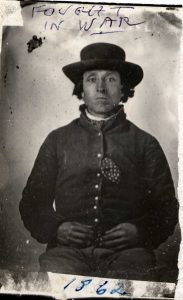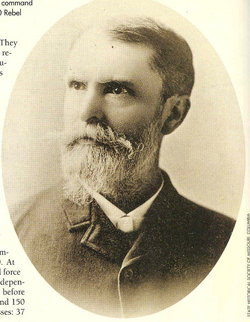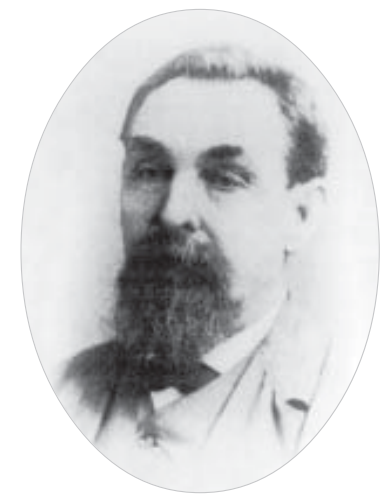Lone Jack – The Fight for Control of Northwest Missouri
By the summer of 1862, the guerrilla war on Missouri’s western border was spiraling out of control for Federal authorities. The year prior, the pro-secessionist government was forced to flee the capital city, allowing the Federals to install a new Unionist provisional government at Jefferson City. To add, the Missouri State Guard, who were victorious at the Battles of Wilson’s Creek and Lexington, were unable to capitalize on their successes retired further south. Due to this shift in power, the growth of the Unionist State militia, and repeated attacks against pro-Southern civilians across the western border, guerrilla units were organized with the intent to oust the Federal authorities, seek revenge, and cause chaos.

In response to the growing threat of insurgency throughout the state toward the end of 1861, the Missouri State Militia (MSM) was created with Federal funding and state control to maintain security and protect vital lines of communication and supply. Each MSM unit was locally recruited, which meant that the rank-and-file knew their area of operations as well as any guerrilla. Other militia units were created in the summer of 1862 named the Enrolled Missouri Militia, or EMM. Unlike the MSM, which consisted of volunteers, the EMM was largely draftees. Missouri’s Provisional Governor Hamilton R. Gamble issued Order No. 19 that required all military-aged males to join the EMM and to confiscate all weaponry and munitions from private hands for military use. In response, Confederates ramped up their recruitment efforts, trying to draw away secessionist Missourians to join the Rebels.
In early 1862, Missouri State Militia established outposts for counterinsurgency operations across northwestern Missouri, including Warrensburg, Pleasant Hill, and Independence. They were dealing with an enemy that refused to abide by the traditional rules of war and conventional Napoleonic tactics. The Missouri guerrillas operated near their homes in the Sni-A-Bar Valley, were supported by many of their neighbors and knew the terrain better than the occupying militiamen. Additionally, guerrillas attacked their enemies using hit-and-run tactics and were many times each armed with multiple revolvers.
That August, the Missouri State Militia grew more frustrated with their situation. The guerrillas repeatedly picked off militiamen as they ventured into or near the Sni Valley, and cut off their lines of communication and supply. The guerrillas also assisted the leaders of the Missouri State Guard with recruitment north of the Missouri River.
On August 11, Colonels John T. Hughes, Upton Hays, Gideon Thompson, and Captain William Quantrill’s force of 700 soldiers and guerrillas struck the Missouri State Militia’s base at Independence. This successful attack and the prevalence of Confederate recruiters in the region greatly concerned the Union authorities. By August 15, Confederate forces arrived in the town of Lone Jack in Jackson County and set up their encampments and pickets.
In an effort to forever rid northwest Missouri of the guerrilla and Confederate presence, the Federals planned a major counteroffensive. Approximately 1,300 troops under Major Emory Foster and Brigadier General Fitz H. Warren were to converge at the small town of Lone Jack where their military intelligence placed the Confederate troops. After defeating them there at Lone Jack, Foster and Warren’s forces would pin the Confederates and guerrillas along the Missouri River, while 2,500 soldiers under Brigadier General James Blunt would swing to the north from Fort Scott, Kansas, and trap them.
On the evening of August 15, Foster’s cavalry and artillery arrived in Lone Jack, just hours after their adversaries. Since early that morning, Foster’s men – about 800 in total – had been on the move from Lexington to Lone Jack. His force consisted of portions of the 7th Missouri State Militia (MSM) Cavalry, 7th Missouri Cavalry, 6th MSM Cavalry, 8th MSM Cavalry, Long’s 2nd Battalion of the MSM Cavalry, and Devlin’s Section of the 3rd Indiana Independent Light Artillery. Like many instances between Union militia and the guerrillas, whose cyclic wars were immensely personal, Foster and his men were out to get revenge against the Rebels and had a reputation for fierce fighting against the guerrillas. A part of that may have been Foster’s own experience, whose older brother was killed by a man in Warrensburg who would later be a Confederate officer in Missouri. Though these men were determined to fight, they were also alone in enemy territory – Jackson County was home to Quantrill’s Raiders.

I passed along the whole line, observing the temper of the men,” wrote Foster, describing the youthfulness and inexperience of his soldiers, “Many of them had never been under fire. Their very inexperience gave them an air of confidence and enthusiasm. Others, however, had seen service, and these, after the manner of experienced soldiers, having, since the coming of daylight, quietly accepted death, were no longer either enthusiastic or afraid. Such men are cool and efficient fighters. It may be a fault in a commanding officer to be careless of danger, but it certainly lends strength and courage to the soldier to no longer fear wounds or death.”[1]
One of the issues Foster unknowingly faced was that the two Federal columns he awaited for at Lone Jack were delayed. Though they were alone, Foster knew the enemy was positioned somewhere south of the town. To probe the enemy lines, Foster ordered his two field guns and fired shots toward the enemy position. There was a brief firefight late in the evening against the Rebel outposts, and Foster had his men encamped in the town of Lone Jack. He hoped to attack the Confederate positions in the morning. The remaining hours of the night were quiet for the militiamen. However, Cockrell’s Confederates now knew of Foster’s position and were looking for a fight.
Around 1,500 Confederates and guerrillas gathered among the hills to the south of Lone Jack. Confident that his forces easily outnumbered Foster’s, Cockrell devised the plan of attack for dawn. Hays’ mounted force would attack from the north, forcing Foster to face the threat, while Colonels John Tracy, Sidney D. Jackman, and DeWitt Hunter would attack from the west. Surprise was a key element to the attack.

Around midnight, Lt. Col. Jackman gave a “little mid-night speech” to his men, “informed them of the decision and show them the necessity. I insisted that they remember that, that was our country, the home of our mothers and sisters and wives and children and everything dear to us, on this earth. We must whip the enemy and hold it, or be whipped and driven from it. Let us meet them as men. Keep cool. Shoot low. Give these shots, boys, and the work will be done.”[2]
Early on the morning of August 16, just before Hays’ attack was supposed to commence, a shot from his line rang out. The sharp, loud bang alerted the Federal pickets, who quickly ran back to the mainline to awaken the others. Soon enough, Foster’s men were ordered into position.
In his post-war recollections of the battle, the Federal commander at Lone Jack described his men’s positions: “The part of the village occupied by the Federal force is known as New Town, the older part of the village lying farther northward. The new town is located on the summit of a high prairie ridge, overlooking the surrounding country. On the east of this new town is a field of growing corn, surrounded by a hedge of Osage orange, strong and tall. The hedge row, which bounds this field on the west, lies only a few yards behind the houses along the eastern line of the street. These buildings, abandoned by their owners who find shelter farther north, are at once occupied by the Federals, expecting an attack from the west. Behind these buildings—between them and the hedge—they take position, the center of their line resting on a blacksmith shop—an excellent support. Here is the artillery commanding the street from end to end. This line, protected by wooden walls in front, is guarded from attack in the rear by the hedge, impassable save at the entrance to the field in the rear of the blacksmith shop. The horses are in the field east of us among the growing corn, surrounded by the hedge. This disposition of the small force seems to one without military experience or special strategic ability not wanting in advantage, and perhaps the best that could be made with so short a time for examination of the field. On the western line of the street are buildings, and behind these a field of hemp, or rank-growing weeds. It is the season when such vegetation has reached its largest growth, and a man on horseback might hide himself in this field.”[3]
The element of surprise was now gone and gave the militia time to deploy. Though Hays’ men on the left flank were supposed to lead off, it was actually the Confederate center and right flank that rushed forward to begin the attack on Lone Jack. It was not a simple task for the Southerners, as they had to clamor through the tall weeds, but they stormed ahead. With heavy casualties, Foster’s right flank soon collapsed and withdrew further into town towards headquarters at the Blacksmith’s shop in town.
As the Rebels pushed into town from the north and northwest, two Federal units were able to pour crossfire on the enemy from behind the hedgerows. Long’s Battalion of MSM Cavalry and, armed with two James Rifles, the section of the 3rd Indiana Independent Artillery opened up on the Confederates, forcing them back to the weeds.
On the Federal left, the 6th MSM Cavalry was forced back through town from Hunter’s advance. On Hunter’s right flank, a small cavalry force pushed east with the intent of flanking the Union left. However, a detachment of about three Federal cavalry companies under the command of Captain Elias Slocum stormed toward the Confederate cavalry that was now buffered by the hedgerows. According to Foster, “Here was one of the deadliest spots on the bloody field of Lone Jack. But the killing here was all done by Slocum, for so great was the confusion of among the guerrillas.”[4] The confusion of the attacks on the southern end of the battlefield and a lack of ammunition led to Hunter temporarily abandoning the field, weakening the Confederate’s line to the south.

On the northern end of the battlefield, Hays and Tracy’s commands pushed on towards the Indiana guns. Bloody close combat broke out and the Rebels captured the two James rifles. Though discouraged and shaken, Foster gathered a small unit of MSM cavalry together to take back the guns. After a close fight, they took back their prized field guns. Demoralized from losing the captured guns, the Confederates momentarily lost confidence until Hays was able to rally them for an attack on the Federal lines. Fighting continued back and forth through the morning.
During all the chaos in town, the Cave Hotel, which was used as a field hospital and sniper’s nest by Federals, was set on fire by Jackman’s troops. On the other side, a Confederate sniper’s nest was in a small occupied house to the north, which sustained heavy fire from the two James rifles. Some of the Confederates from Hunter and Jackman’s commands approached the position of the Indiana section to take out the guns. Once the commander of the Indiana section fell severely wounded, both sides ran at each other, resulting in a brutal hand-to-hand fight. In the midst of the fight, Foster and Long, with about sixty men, stormed towards the James rifles and forced the Confederates to abandon their prize yet again. However, Foster was severely wounded in the fight, but would survive.
Around 10:30am, the Federals watched their Confederate counterparts stagger from the field. Just as they cheered for a Union victory, approximately 800 fresh Rebels under Colonel John T. Coffee appeared on the north side of town. With heavy casualties among their own officers and many wounded horses, the Federals had no choice but to surrender.
A Confederate victory, the Battle of Lone Jack resulted in the possession of northwestern Missouri for the Rebels, particularly the guerrillas, for at least another year. When Blunt’s force finally arrived just after the battle, Confederate troops were unable to hold their position in the region and were able to move south to safety toward Arkansas. However, the battle gave just a glimpse at the ferocity of combat – especially within towns and communities – that would continue on for the war along Missouri’s western border. In one year, Quantrill’s Raiders would sack Lawrence and the infamous Order No. 11 would be issued by the Federals to cleanse the western border of insurgency. Lone Jack was only the beginning of a deadly, destructive, and horrific war on the border.
Sources:
- Emory Foster, “Tales of the War,” in Missouri Republican, August 1, 1885, St. Louis, MO.
- Sidney D. Jackman, Behind Enemy Lines: The Memoirs and Writings of Brigadier General Sidney Drake Jackman (Springfield, MO: Oak Hills Publishing Company, 1997).
- Foster, “Tales of the War.”
- Ibid.
Further Reading:
Matt Matthews and Kip Lindberg, “Shot All to Pieces: The Battle of Lone Jack, Missouri, August 16, 1862,” North & South Magazine, January 2004, Vol 7, No 1,
Thanks to Kristen M. Trout for the informative report, and for providing an opportunity to further examine and discuss the endlessly evolving situation in Missouri in 1862.
Following on from Major General Henry Halleck securing Missouri for the Union in April 1862, he turned over acting- command of his office at St. Louis to BGen John Schofield and accompanied newly-minted Major General John Pope to Pittsburg Landing. Halleck took command in the field and prepared his army of 100,000 men for the advance on Corinth Mississippi that “would crush out Rebellion in the West.”
In Missouri, the Union A-team was gone: Halleck was replaced by acting-commander Schofield until SEP 1862, when Major General Samuel Curtis was assigned as Commander, Department of Missouri; BGen Ben Loan, based at St. Joseph, replaced the highly successful guerrilla-fighter, Benjamin Prentiss in Northern Missouri; BGen Samuel Sturgis was sent to command Department of Kansas; and John Schofield remained in control of Missouri’s Federal Militia through 1862.
Meanwhile, Confederate Major General Earl Van Dorn, defeated at Pea Ridge, was assigned to Beauregard’s Army of the Mississippi and brought his forces east, across the Mississippi River to Memphis, and thence by rail to join Beauregard at Corinth. Brigadier Generals Sterling Price and Mart.E.Green also joined Beauregard at Corinth, as component of Van Dorn’s Army of the West. Left behind in Missouri: M.Jeff.Thompson; and “others” [as mentioned by Kristen M. Trout] with authority granted by the Partisan Ranger Act of 1862, determined to continue the fight.
Thanks for reading and for commenting, Mike!
Just because this seems a good place to add the information…
The attached list, generated and published by NPS, is provided as partial evidence of “how confused was the Civil War situation in Missouri.” Notice how pro-Confederate/ Rebel casualties are mostly not indicated. Also, most pro-CSA/ Rebel units engaged are not identified. Of additional concern: very many engagements, deemed smaller than “skirmish” in size are not listed. These “actions” include Mark Twain’s Civil War experience (ambush of a lone rider, believed to be pro-Union); the repeated persecution of Major James Rollins – Father of University of Missouri – by pro-CSA Captain Sweeney in Columbia Missouri; and the Platte River derailment of a westbound express train of the Hannibal & St. Joseph Railroad on 3 SEP 1861, by pro-CSA guerrillas, which resulted in over 100 casualties – most civilians. Also not included: Jayhawker Charles Jennison’s operations in West Missouri (which could be used as justification for Quantrill’s Raiders); the actions of the 18th Missouri Infantry (USA) while under command of Colonel W. James Morgan, causing his replacement by Colonel Madison Miller; and the authority granted MGen Henry Halleck by President Lincoln “to suspend Habeas Corpus within the limits of his Department, effective 2 NOV 1861.” https://www.nps.gov/civilwar/missouri.htm